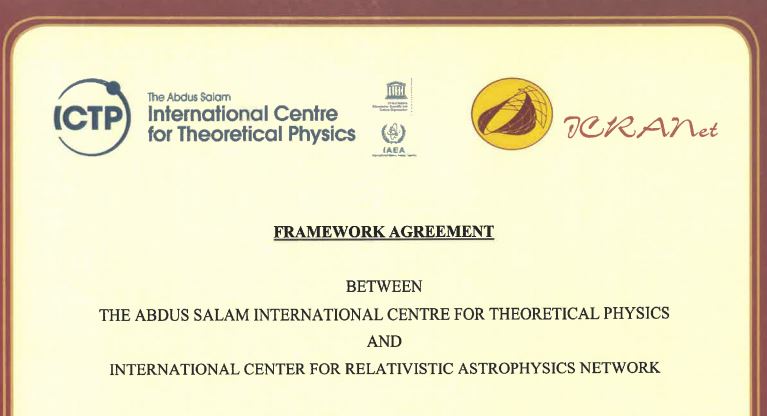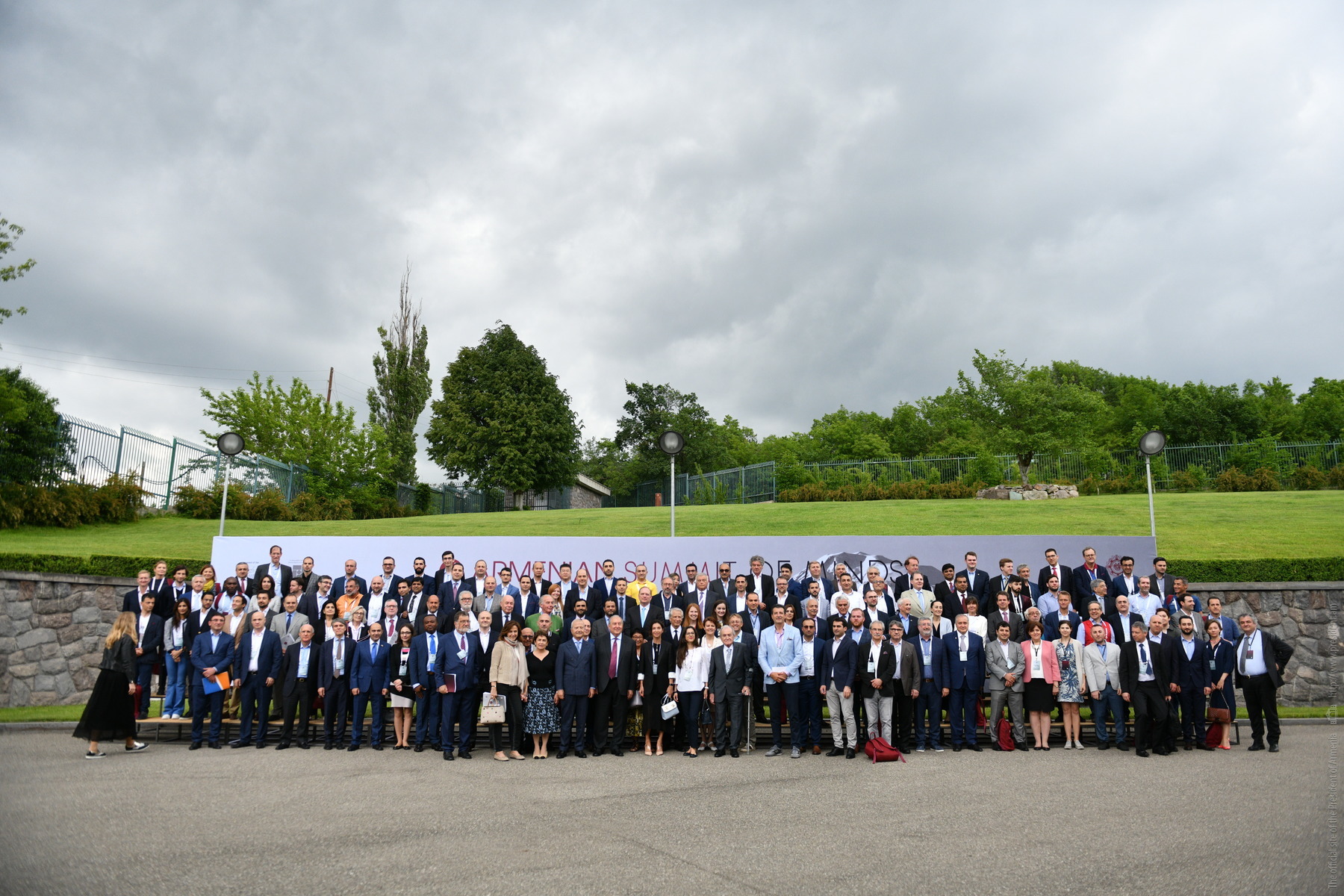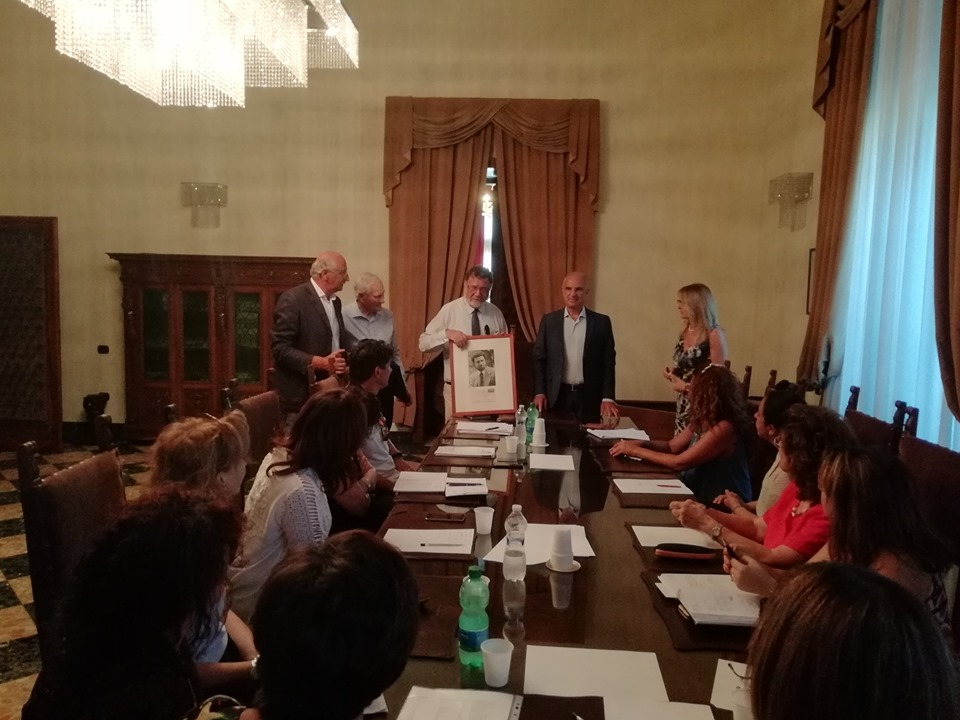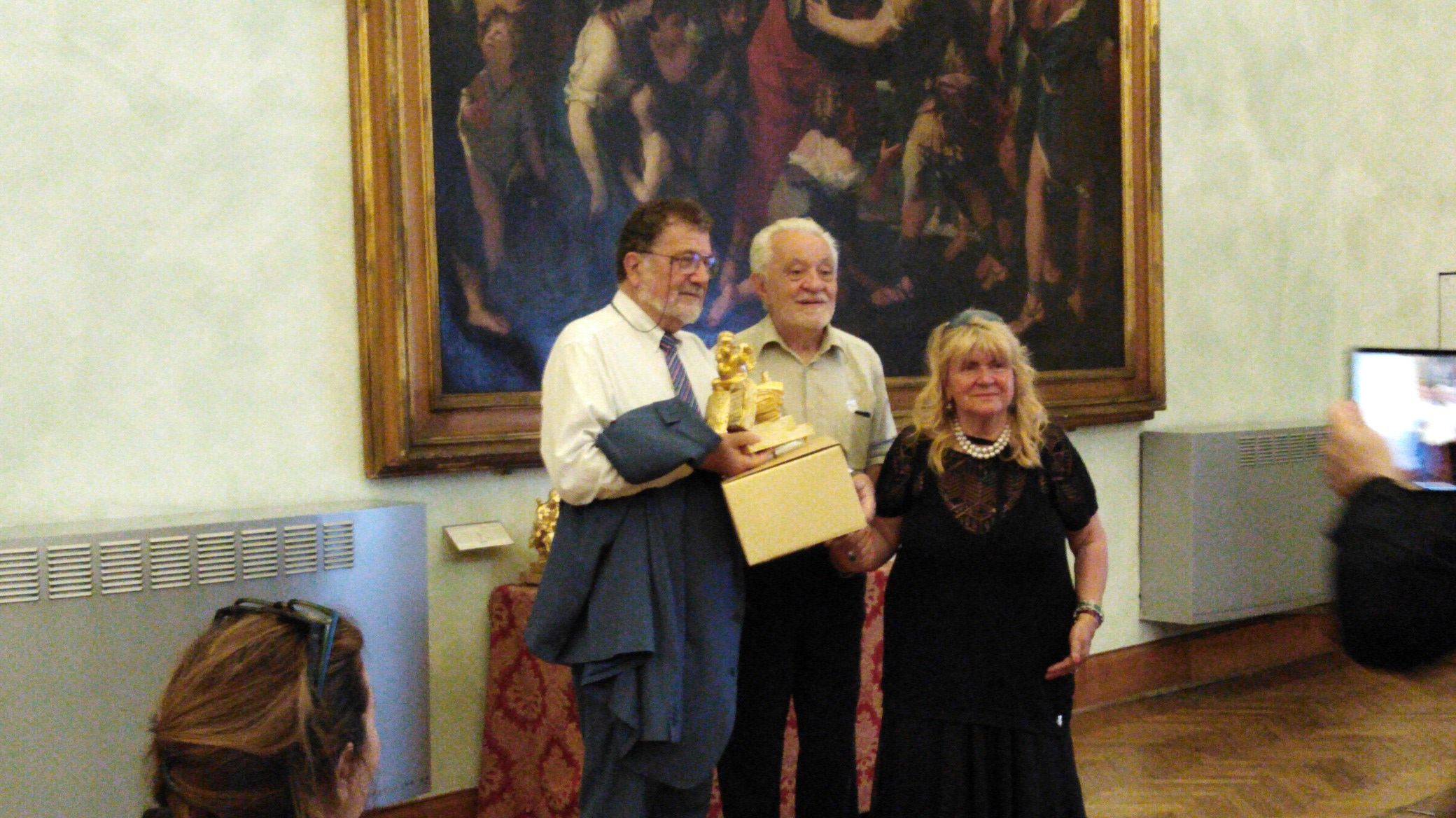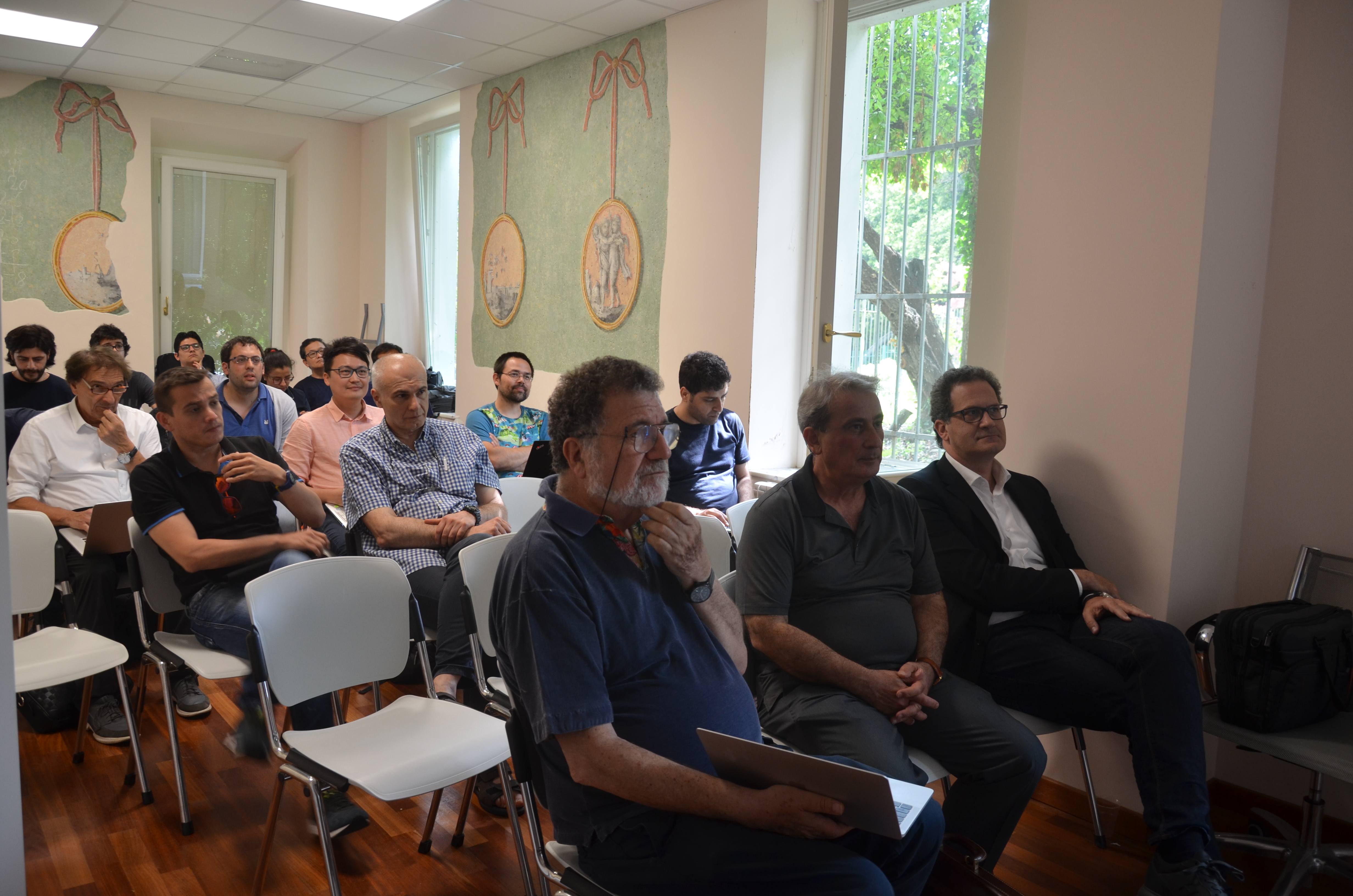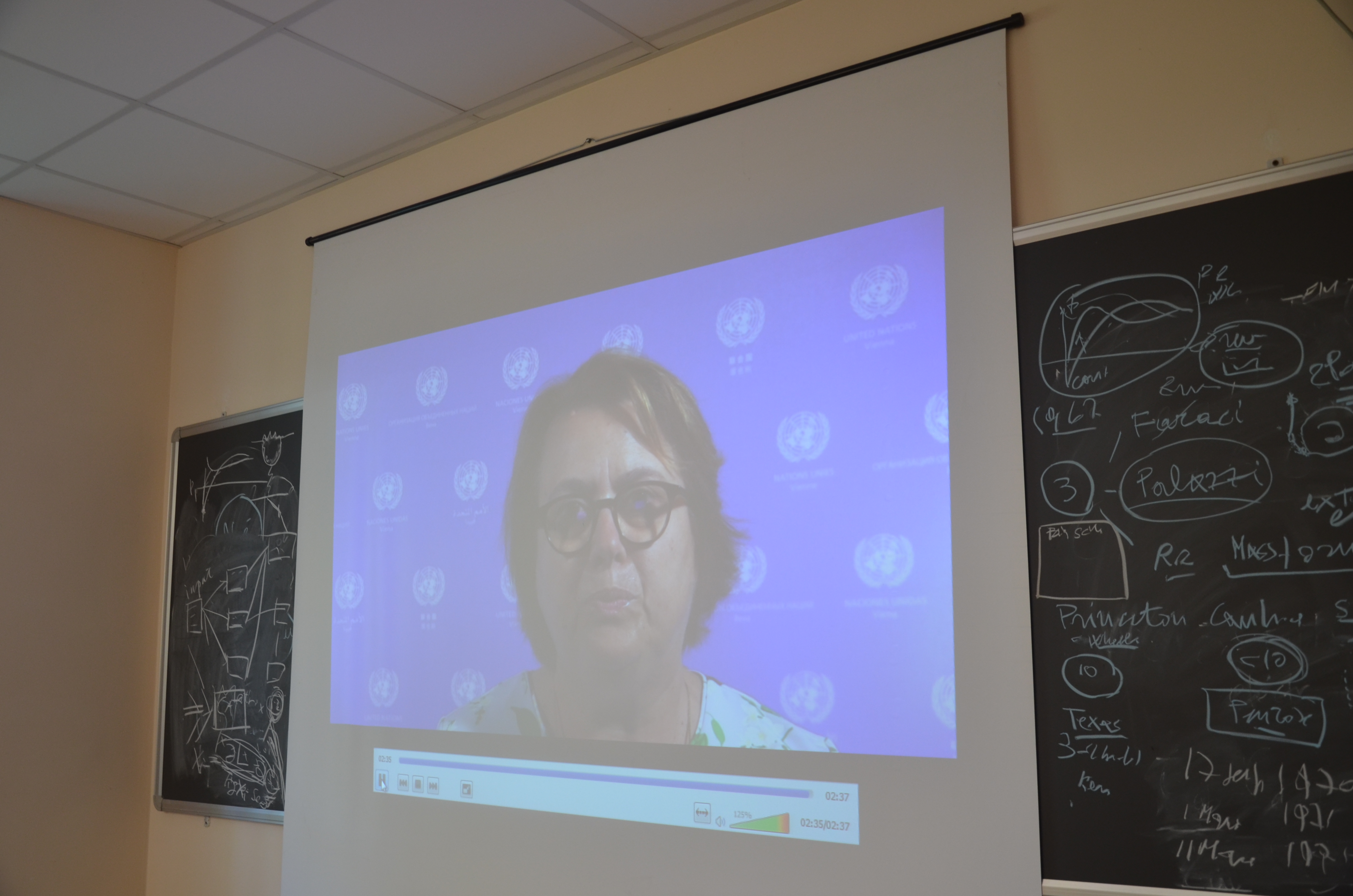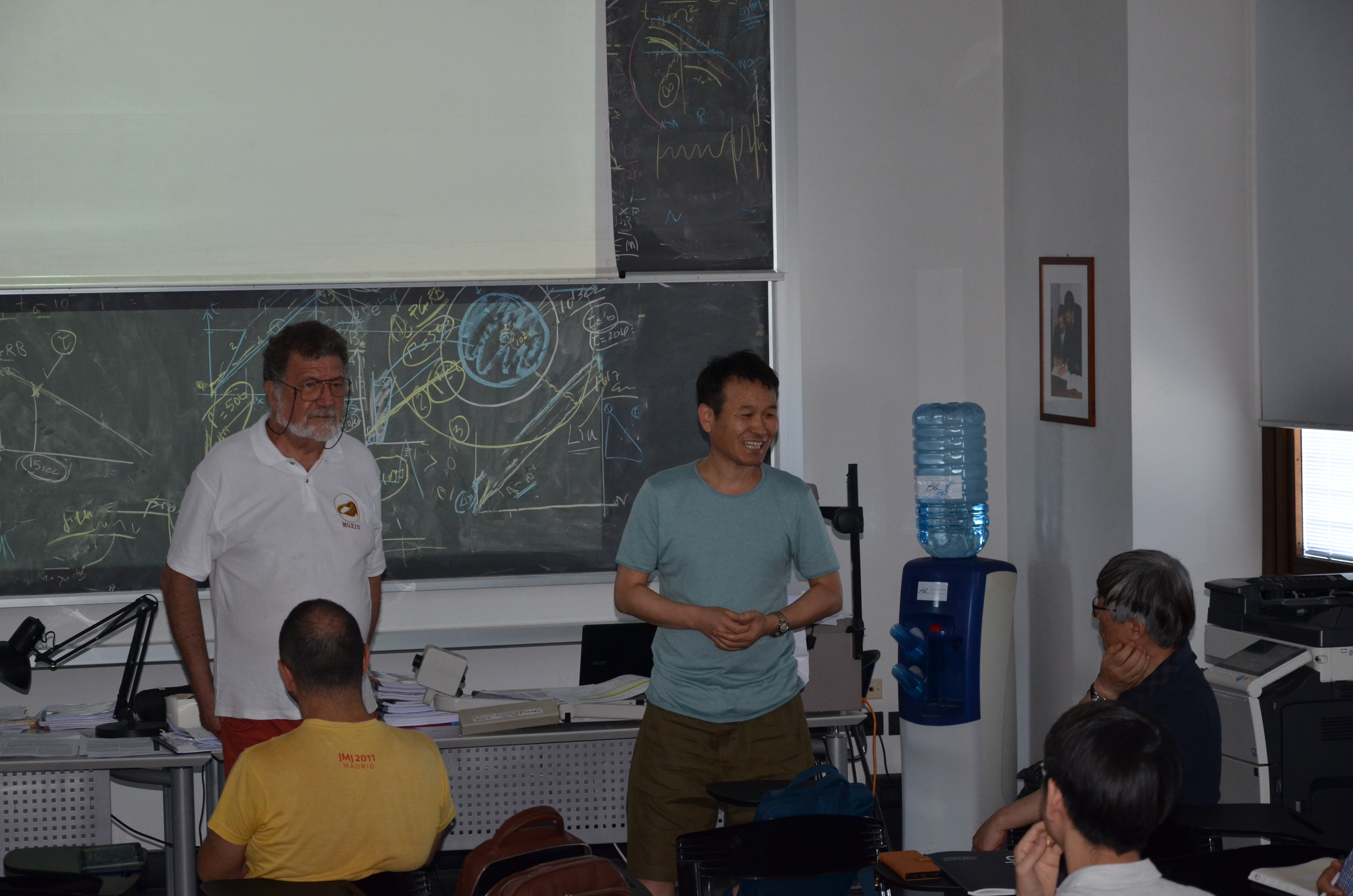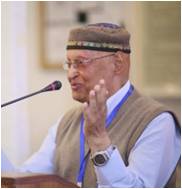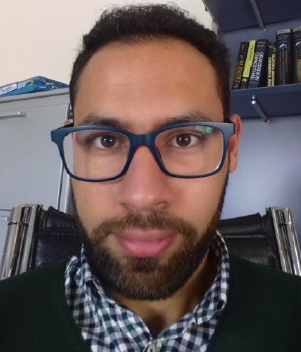

| Newsletter English June/August 2019 |

|

|





ICRANet Newsletter
2014 -
2015 -
2016
2017 - 2018 2019 February/March - April/May - June/August - September/October - November/January 2020 2020 - 2021 - 2022
ICRANet Newsletter
June - July - August 2019
SUMMARY
1. On the role of a cavity in the hypernova ejecta of GRB 190114C 2. New collaboration agreement between ICTP and ICRANet, August 7, 2019 3. New collaboration agreement between Silesian University in Opava and ICRANet, August 19, 2019 4. Prof. Ruffini at the Armenian Summit of Minds Yerevan-Dilijan, Armenia, June 7-9, 2019 5. 62nd session of the Scientific and Technical Subcommittee of COPUOS (UNOOSA), Vienna, Austria, June 19, 2019 6. Prof. Roy Kerr and Prof. Ruffini met the Mayor of Pescara, July 23, 2019 7. Visit of Prof. Ruffini at Stanford University, USA, August 24 – 31, 2019 8. Prof. Roy Kerr official nomination as Fellow of the Royal Society, London, United Kingdom, July 12, 2019 9. Prof. Ruffini awarded Commander of the Order of Merit of the Italian Republic, June 2, 2019 10. Prof. Ruffini awarded the Prize Lucio Colletti, Rome, Italy, June 14, 2019 11. Open Universe International doctoral School “The discovery of Black Holes”, Nice, France, June 11 - 14, 2019 12. 16th Italian-Korean Symposium on Relativistic Astrophysics, Pescara, Italy, June 1-5, 2019 13. Scientific visits to ICRANet 14. Recent publications
1. On the role of a cavity in the hypernova ejecta of GRB 190114C
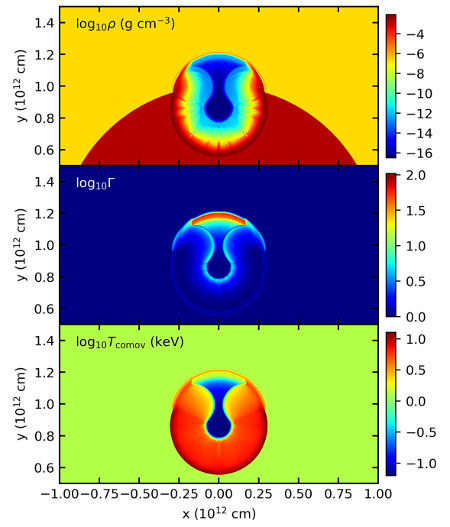
Fig. 1. Spatial distributions of matter density (top), Lorentz factor (middle) and comoving temperature (bottom) at t = 11s, showing the mildly relativistic reflection wave propagating backward in the cavity, as well as the ultrarelativistic e+e- plasma wave propagating outside the cavity. The shock wave is visible inside the ejecta. The paper with this title co-authored by R. Ruffini, J. D. Melon Fuksman, G. V. Vereshchagin has been accepted for publication by the Astrophysical Journal on 19 of August 2019. It presents an evidence of formation of a cavity in the source of gamma-ray burst GRB190114C. It is proposed that this GRB originates in a binary system composed of a massive carbon-oxygen core, described within the binary-driven hypernova I (BdHN I) scenario. In this scenario the carbon-oxygen core undergoes a supernova explosion with the creation of a new neutron star, hypercritical accretion occurs onto the companion binary neutron star until it exceeds the critical mass for gravitational collapse. The formation of a black hole captures 1057 baryons by enclosing them within its horizon, and thus a cavity of approximately 1011 cm is formed around it with initial density 10-7 g/cm3. A further depletion of baryons in the cavity originates from the expansion of the electron-positron-photon plasma formed at the collapse, reaching a density of 10-14 g/cm3 by the end of the interaction. It is demonstrated using an analytical model complemented by a hydrodynamical numerical simulation that part of the electron-positron-photon plasma is reflected off the walls of the cavity. The consequent outflow and its observed properties are shown to coincide with the featureless emission occurring in a time interval of duration, measured in the rest frame of the source, between 11 and 20 s of the GBM observation. Moreover, similar features of the GRB light curve were previously observed in GRB 090926A and GRB 130427A, all belonging to the BdHN I class. This interpretation supports the general conceptual framework presented in (Ruffini et al. 2019) and guarantees that a low baryon density is reached in the cavity, a necessary condition for the operation of the “inner engine” of the GRB presented in an accompanying article (Ruffini & Moradi 2019). References:
2. New collaboration agreement between ICTP and ICRANet, August 7, 2019
On August 7, 2019 ICRANet signed a cooperation agreement with ICTP (the Abdus Salam International Centre for Theoretical Physics), which will be valid for 5 years. The document was signed by Prof. Fernando Quevedo, Director of ICTP, and Prof. Ruffini, Director of ICRANet. The main joint activities to be developed under the framework of this agreement include: the promotion of theoretical and observational activities within the field of Relativistic Astrophysics; the institutional exchange of faculty members, researchers, post-doctorate fellows and students; the promotion of technological developments; the development of Data Centers for Astrophysical data in all wavebands; the organization of training and teaching courses, seminars, conferences, workshops or short courses, and the development of inter-institutional research areas associated to local graduate programs; and joint publications. For the text of the agreement, see here.
3. New collaboration agreement between Silesian University in Opava and ICRANet, August 19, 2019
On August 19, 2019 ICRANet signed a cooperation agreement with the Silesian University in Opava (Czech Republic), which will be valid for 5 years. The document was signed by Doc. Ing. Pavel Tuleja (Rector of the Silesian University), by Prof. Zdenek Stuchlik (Head of the Research center for theoretical physics and astrophysics), by Prof. Ruffini (Director of ICRANet) and by Prof. Jorge Rueda (ICRANet Faculty Professor). The main joint activities to be developed under the framework of this agreement include: the promotion of theoretical and observational activities within the field of Relativistic Astrophysics; the institutional exchange of faculty members, researchers, post-doctorate fellows and students; the promotion of technological developments; the development of Data Centers for Astrophysical data in all wavebands; the organization of training and teaching courses, seminars, conferences, workshops or short courses, and the development of inter-institutional research areas associated to local graduate programs; and joint publications. The agreement will be deliver in person to Prof. Ruffini and Prof. Rueda during the RAGtime meeting, which will be held in Opava in September 2019. For the text of the agreement, see here.
4. Prof. Ruffini at the Armenian Summit of Minds Yerevan-Dilijan, Armenia, June 7-9, 2019
From 7 to 9 June 2019, Professor Ruffini, Director of ICRANet, was invited by the President of the Republic of Armenia, H. E. Armen Sarkissian, to participate to the Armenian Summit of Minds 2019. This meeting was an opportunity for participants to experience simultaneously the most ancient and the most innovative that the country has to offer, a special mix of hard thinking and experiential learning. High level representatives in the field of international politics and economy were present.
On the first day, Prof. Ruffini was invited to participate to the welcome reception hosted by H.E. Armen Sarkissian at the Central Bank of
Armenia's Dilijan Training and Research Centre.
On the following day, Prof. Ruffini delivered a talk titled “On the quantum nature of GRB 190114C” in the framework of the afternoon workshop on hi-tech and governance. On that evening, he also attended the official dinner organized by President Sarkissian together with high level personalities, such as Dominique de Villepin, former Prime-Minister of France. For videos of the conference, check here
5. 62nd session of the Scientific and Technical Subcommittee of COPUOS (UNOOSA), Vienna, Austria, June 19, 2019
The Scientific and Technical Subcommittee of the Committee on the Peaceful Uses of Outer Space (COPUOS) held its sixty-second session at the United Nations Office at Vienna from June 12 – 21, 2019. Professor Ruffini joined the conference on June 19 and, on that day, he was invited to participate to a working dinner by H.E. Ambassador Maria Assunta Accili (Permanent Representative of Italy to the International Organizations in Wien) in her residence. On that occasion Prof. Ruffini had the possibility to illustrate to all the participants the latest scientific results achieved by ICRANet, as well as to open an international dialogue with the highest representatives of UNOOSA (United Nations Office for Outer Space Affairs) and its Director, H.E. Simonetta Di Pippo.
6. Prof. Roy Kerr and Prof. Ruffini met the Mayor of Pescara, July 23, 2019
On Tuesday July 23 Prof. Roy P. Kerr (New-Zealander mathematician and physicist, holding the Yevgeny
Lifshitz Chair at ICRANet and Crafoord Prize in Astronomy 2016), met the Mayor of Pescara, Dr Carlo
Masci, accompanied by Prof. Remo Ruffini, Director of ICRANet. Prof. Kerr, the discoverer of the “Kerr
metric”, was awarded the Albert Einstein medal by the Albert Einstein Society in 2013 and has just been
nominated Fellow of the Royal Society. He is an honorary citizen of Pescara since 2016 and has been in
ICRANet center in July in order to further work with Prof. Ruffini and ICRANet scientists on black holes.
During the meeting, on the occasion of the anniversary of first moon landing, Prof. Ruffini showed to Dr
Masci the letter with the issue of the first stamp with the image of Armstrong on the moon, sent from
Princeton on July 20, 1969. The Mayor expressed to Prof. Kerr and Prof. Ruffini his gratitude for their visit
and for their strong contribution to science, as well as his support to further strengthen the collaboration with
ICRANet, a flagship for the city of Pescara and for its culture. He also presented the 2 scientists to a
delegation of school leaders that was in the same building for a meeting with the city administration,
highlighting the importance of a strong collaboration among scientists and schools in order to spread culture
among students.
7. Visit of Prof. Ruffini at Stanford University, USA, August 24 – 31, 2019
From August 24 to 31, Prof. Ruffini visited Stanford University, founder member of ICRANet, and give
there a seminar titled “On the BdHN I GRB 190114C and its energetics”. This visit was an opportunity for
Prof. Ruffini to participate to several other meetings, as well as to work together with some of his longtime
colleagues and the FERMI team on the latest scientific results on which ICRANet is also working on.
8. Prof. Roy Kerr official nomination as Fellow of the Royal Society, London, United Kingdom, July 12, 2019
On July 11, Professor Ruffini, Director of ICRANet, took part in the formal admission ceremony of Professor Roy P. Kerr as Fellow of the Royal Society, which was held on July 12 at the seat of the Royal Society in London. Professor Kerr was awarded by the Royal Society this high and prestigious title "for the solution of Einstein's equations of General Relativity for rotating black holes, an epochal result now known as the Kerr metric, describing Kerr black holes. Other major contributions include prescient work on algebraically special solutions of reduced holonomy".
9. Prof. Ruffini awarded Commander of the Order of Merit of the Italian Republic, June 2, 2019

Fig. 7: Prof. Remo Ruffini awarded Commander of the Order of Merit of the Italian Republic with the Prefect of Pescara, H.E. Gerardina Basilicata (on the right) and the then Mayor of Pescara, Dr Marco Alessandrini (on the left). Photo credit to Il Pescara. On Sunday June 2, 2019, Prof. Remo Ruffini, Director of ICRANet, was awarded Commander of the Order of Merit of the Italian Republic by the Prefect of Pescara, H.E. Gerardina Basilicata, on the occasion of the Italian Republic day. The official ceremony was held in the city center of Pescara, at the presence of the highest local institutional, military and religious authorities. Among them, the then Mayor of Pescara, Dr Marco Alessandrini. The Order of Merit of the Italian Republic was founded as the senior order of knighthood by the second President of the Italian Republic, Luigi Einaudi in 1951. The highest ranking honor of the Republic, it is awarded for "merit acquired by the nation" in the fields of literature, the arts, economy, public service, and social, philanthropic and humanitarian activities and for long and conspicuous service in civilian and military careers. The order is classified in 6 kinds of classes, and Prof. Ruffini was awarded the 3rd class, Commander. For a press release on that event: http://www.ilpescara.it/attualita/festa-repubblica-2-giugno-pescara-piazza-garibaldi-cerimonia-foto.html For videos of the ceremony: • Rete 8: http://www.rete8.it/cronaca/249492/ • Rai 3 (Tg Regional): https://www.rainews.it/tgr/abruzzo/notiziari/video/2019/06/ContentItem-79d089f5-2678-4b54-abc9-9daa4bc637a4.html
10. Prof. Ruffini awarded the Prize Lucio Colletti, Rome, Italy, June 14, 2019
On June 14, 2019 Professor Remo Ruffini, Director of ICRANet, was awarded the Price "Lucio Colletti" 2019 by the Lucio Colletti Foundation. The ceremony took place in the "Sala Pietro da Cortona" of the Camipoglio, the seat of Rome Municipality and the awards were delivered to people who, in their specific field of study, stand out for their courage, freedom and accuracy. Professor Ruffini was very grateful for this recognition and thanked all the organization for their kindness and regard.
11. Open Universe International doctoral School "The discovery of Black Holes", Nice, France, June 11 - 14, 2019
The Open Universe International Doctoral School "The discovery of Black Holes. How the discovery of a Black Hole in GRB 190114C and in M87 is modifying the human outlook from planet Earth" has been held at ICRANet Seat at Villa Ratti (Nice - France) from June 11 - 14, 2019. This 5 days conference has been organized thanks to the collaboration among ICRANet, LAPP (Laboratoire d'Annecy de Physique des particules) and the Max Planck Institute for Physics. The opening addresses and the conclusions were given by Professor Remo Ruffini (Director of ICRANet). During this five days conference, a variety of topics in astrophysics were discussed, such as neutrinos, gamma-ray bursts and compact stars, high energy cosmic rays, dark energy and dark matter, general relativity and black holes. The most recent scientific developments were presented by eminent Professors and researchers, such as: Prof. Ulisses Barres De Almeida (CBPF, Rio de Janeiro), Prof. Zurab Berezhiani (Università degli Studi dell’Aquila), Prof. Elisa Bernardini (DESY - Zeuthen, University of Padova), Prof. Paolo Giommi (ASI), Prof. Giovanni Lamanna (Director of LAPP, Annecy), Prof. Mirabel Felix (IAFE), Prof. Jorge A. Rueda H. (ICRANet), Prof. Razmik Mirzoyan (Max Planck Institute for Physics,Munich), Prof. Narek Sahakyan (Director of ICRANet Armenia), Prof. Gregory Vereshchagin (ICRANet), Prof. Shesheng Xue (ICRANet), Dr Martin Kolos (Silesian University in Opava), Dr Arman Tursnov (Silesian University in Opava), Dr Yu Wang (ICRANet), Eduar Becerra (ICRANet), Stefano Campion (ICRANet), Yen-Chen Chen (ICRANet), David Melon Fuksman (ICRANet), Riccardo Middei (Università Degli Studi Roma Tre), Moradi Rahim (ICRANet), José F. Rodriguez R. (ICRANet) and Juan David Uribe Suarez (ICRANet). On Wednesday 12, H.E. Simonetta Di Pippo, Director of UNOOSA, sent a video message to the participants to the Open Universe School, in order to outline once again the leading role and the outstanding scientific results achieved by the Open Universe initiative. For photos, program and more information about the event: http://www.icranet.org/OpenUniverseSchool
12. 16th Italian-Korean Symposium on Relativistic Astrophysics, Pescara, Italy, June 1-5, 2019
The 16th Italian-Korean Symposium on Relativistic Astrophysics has been held at ICRANet center in Pescara from July 1 - 5, 2019. The Italian-Korean Symposia on Relativistic Astrophysics is a series of biannual meetings, alternatively organized in Italy and in Korea since 1987. The opening addresses and the conclusions were given by Professor Hyung Won Lee (Inje University - Korea) and Professor Remo Ruffini (Director of ICRANet). During this five days conference, a variety of topics in astrophysics and cosmology were discussed, such as gamma-ray bursts and compact stars, high energy cosmic rays, dark energy and dark matter, general relativity, black holes, and new physics related to cosmology. The most recent scientific developments were presented by eminent Professors and researchers. The Korean speakers were Prof. Hyung Won Lee, Prof. Aera Jung (Department of engineering physics, Tsinghua University - China), Prof. Sung-Won Kim (Ewha Womans University - Korea), Prof. Chang-Hwan Lee (Pusan National University - Korea), Prof. Dong-Han Yeom (Pusan National University - Korea) and Prof. Jin Young Kim (Kunsan National University - Korea). Speakers from ICRANet were Prof. Remo Ruffini, Prof. Jorge A. Rueda H., Prof. Gregory Vereshchagin, Prof. Vladimir Belinski, Prof. Shesheng Xue, Prof. Costantino Sigismondi, Dr Wang Yu, Dr José F. Rodriguez R., Dr Liang Li, Dr Gabriel Gomez, Stefano Campion, Rahim Moradi and Rafael Yunis. On Wednesday evening (July 3), there was the official IK16 banquet, held at Hai Bin wok restaurant in Pescara, and this was an interesting opportunity for all the participants to discuss in about science in an informal way. For photos, program and more information about the event: http://www.icranet.org/ik16
13. Scientific visits to ICRANet
During the summer, several relevant scientists and students visited our ICRANet center in Pescara, namely:
• Prof. Roy P. Kerr (Yevgeny Lifshitz Chair at ICRANet, Crafoord Prize in Astronomy 2016, Fellow of the Royal Society), 19 July – 2 August 2019; • Prof. Hyung Won Lee (Inje University – South Korea), 27 June - 16 July 2019; • Prof. Asghar Qadir (National University of Sciences & Technology - Pakistan), 11 - 29 July 2019; • Prof. Yury Vybly (National Academy of Sciences NASB – Belarus), 5 - 15 August 2019; • Dr Soroush Shakeri (Isfahan University of Technology - Iran), 24 - 30 June 2019; • Dr Muhsin Burhan Mohammed Rashid Al-Jaf (University of Science and Technology of China - Hefei), 23 - 26 June 2019; • Dr Gabriel Gomez (Universidad Industrial de Santander – Colombia), 4 - 7 July 2019. During their visit, those scientists had the opportunity to carry on important analysis and research with other ICRANet scientists from all over the world. Following the Agreement between ICRANet and Al-Farabi Kazakh National University, three groups of Kazakh students, under the supervision of Professor Medeu Abishev, Prof. Kuantay Boshkayev and Prof. Saken Toktarbay, visited ICRANet center in Pescara. The first group came from 1 to 14 July 2019, and was composed by: Aidana Bauyrzhan, Zhaniya Kuanyshova, Yerkebulan Kabulbek, Bediyar Zhumadil and Arailym Tolegen. The second and the third groups came both from 10 to 24 July, and were composed by: Sandugash Imanbay, Ardak Omargali, Sandugash Toktarbek, Balnur Kusmanova, Tokhir Rametov, Nursultan Seitkerim, Alua Tussupbekova, Arailym Murat, Ashen Akmaral and Aigerim Toktamuratova.
14. Recent publications
Li Liang, "Multipulse Fermi Gamma-Ray Bursts. I. Evidence of the Transition from Fireball to Poynting-flux-dominated Outflow", published in The Astrophysical Journal Supplement Series, Volume 242, Issue 2, article id. 16, 33 pp. (2019).
The composition of a jet is still an unsolved problem in gamma-ray bursts (GRBs). Several previous studies have suggested that the prompt emission spectrum of GRBs is likely to consist of a few components that may arise from different jet compositions. Here we present a systematic analysis to search for the GRBs that seem to show the transition from a fireball to the Poynting-flux-dominated outflow between well-separated pulses within a single burst, like GRB 160626B, using the Gamma-ray Burst Monitor data of the Fermi satellite. We obtain 43 GRBs with clear multiple pulses and find that 9/43 (21%) bursts may exhibit such a transition based on the time-integrated spectral analysis. We then select a further four bursts with data of adequate quality to perform a detailed time-resolved spectral analysis, and we find that in three bursts the thermal-like pulse is a precursor. Furthermore, based on the time-resolved spectra, we constrain the outflow properties for those thermal pulses and find them consistent with the typical properties of the photosphere emission. Also, the later pulses with the softer low-energy spectral index are compatible with the optically thin synchrotron emission model. Our analysis indicates that a good fraction of the multipulse Fermi bursts may obtain the transition from fireball to the Poynting-flux-dominated outflow. Link: https://iopscience.iop.org/article/10.3847/1538-4365/ab1b78 P. Giommi, C.H. Brandt, U. Barres de Almeida, A.M.T. Pollock, F. Arneodo, Y. L. Chang, O. Civitarese, M. De Angelis, V. D'Elia, J. Del Rio Vera, S. Di Pippo, R. Middei, A. V. Penacchioni, M. Perri, R. Ruffini, N. Sahakyan, S. Turriziani, "Open Universe for Blazars: a new generation of astronomical products based on 14 years of Swift-XRT data", accepted for publication in Astronomy and Astrophysics. Open Universe for blazars is a set of high-transparency data products for blazar science, and the tools designed to generate them. Blazar astrophysics is becoming increasingly data driven, depending on the integration and combined analysis of large quantities of data from the entire span of observational astrophysics techniques. The project was therefore chosen as one of the pilot activities within the United Nations Open Universe Initiative. In this work we developed a data analysis pipeline called Swift_deepsky, based on the Swift XRTDAS software and the XIMAGE package, encapsulated into a Docker container. Swift_deepsky, downloads and reads low-level data, generates higher-level products, detects X-ray sources and estimates several intensity and spectral parameters for each detection, thus facilitating the generation of complete and up-to-date science-ready catalogues from an entire space-mission dataset. The Docker version of the pipeline and its derived products is publicly available from the Open Universe Website at this http URL. We present the results of a detailed X-ray image analysis based on Swift_deepsky on all Swift XRT observations including a known blazar, carried out during the first 14 years of operations of the Swift Observatory. The resulting database includes over 27,000 images integrated in different X-ray bands, and a catalogue, called 1OUSXB, that provides intensity and spectral information for 33,396 X-ray sources, 8,896 of which are single or multiple detections of 2,308 distinct blazars. All the results can be accessed on-line in a variety of ways: e.g., from the Open Universe portal at this http URL, through Virtual Observatory services, via the VOU-Blazar tool and the SSDC SED builder. One of the most innovative aspects of this work is that the results can be safely reproduced and extended by anyone. Link: https://arxiv.org/abs/1904.06043 Becerra, L.; Boshkayev, K.; Rueda, J. A.; Ruffini, R., "Time evolution of rotating and magnetized white dwarf stars", Monthly Notices of the Royal Astronomical Society, Volume 487, Issue 1, p.812-818, 2019. We investigate the evolution of isolated, zero and finite temperature, massive, uniformly rotating and highly magnetized white dwarf stars under angular momentum loss driven by magnetic dipole braking. We consider the structure and thermal evolution of white dwarf isothermal cores taking also into account the nuclear burning and neutrino emission processes. We estimate the white dwarf lifetime before it reaches the condition either for a type Ia supernova explosion or for the gravitational collapse to a neutron star. We study white dwarfs with surface magnetic fields from 106 to 109 G and masses from 1.39 to 1.46 M⊙ and analyze the behavior of the white dwarf parameters such as moment of inertia, angular momentum, central temperature and magnetic field intensity as a function of lifetime. The magnetic field is involved only to slow down white dwarfs, without affecting their equation of state and structure. In addition, we compute the characteristic time of nuclear reactions and dynamical time scale. The astrophysical consequences of the results are discussed. Journal website link: https://doi.org/10.1093/mnras/stz1394 ArXiv link: https://arxiv.org/abs/1812.10543 |
|||||||||||||||||||||||
|
||
